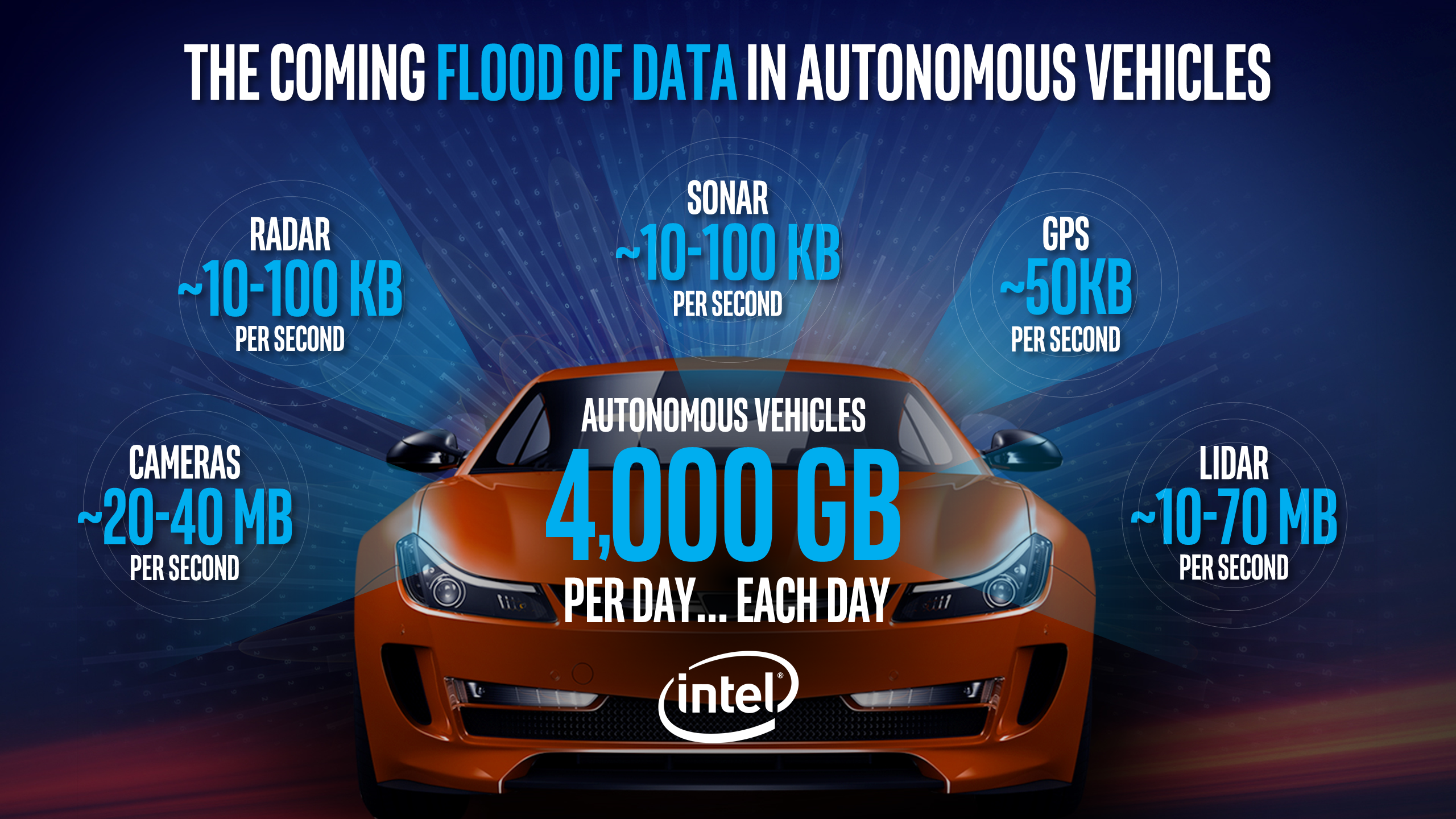The Information revolution is upon us, sometimes referred to as the age of information.
Autonomous cars can generate up to 4TB of data per car… per day!

The Future of Autonomous Cars is closer than you may think with a few road bumps along the way.
Although we may have the technology available to make autonomous cars no longer a thought of future, but reality, we are still miles (no pun intended) from actually achieving everything necessary to make them publicly available. Autonomous cars not only need to be able to operate independently on our roads, but they also need to be able to react to organic changes in the environment. These type of changes are not easily programmed into a computer system. Things like obeying traffic laws and plotting safe routes from point A to destination B are more of the mechanical application side of autonomous driving. There is another side that is harder to grasp for computers. This is the social aspect of driving.
Imagine this simple scenario to illustrate some of the imperative need for cars to have an understanding of human social and ethical values: Your autonomous car has to make a choice. Either swerve left and hit a 7-year old girl, or swerve right and hit a 70-year old grandma. The car is traveling to fast to brake in time and the impact will kill either victim on collision. If you do nothing, both will be killed. What will decide which way to swerve? How will cars be tasked with making these type of decisions?
In the above scenario, some may say the grandmother is the better of the two evils. Thinking that the young girl still has her entire life to live, full of memories to be made and happiness to be had. The grandmother on the other hand having already had a happy and full life herself may be the more logical choice. Nonetheless the grandmother still has the right to live and as valuable life as the girls. There are many reasons that seem to weigh in favor of saving the little girl over the grandmother given the circumstances. The grandmother may in fact insist that the car make the choice to hit her instead of the little girl, if she were given the choice.
Both choices are ethically incorrect, according to the professional codes of ethics upheld by the Institute of Electrical and Electronics Engineers (IEEE). The IEEE pledges “to treat fairly all persons and to not engage in acts of discrimination based on race, religion, gender, disability, age, national origin, sexual orientation, gender identity, or gender expression”. Discriminating on the basis of age in the crash example above would seem to be the same bias as discriminating on the basis of race, religion, gender, disability, national origin, etc. Even then, what will decide what the correct choice is?
Some possible solutions to these issues may be finding a solution that does not involve swerving either way and hitting anyone. However, driving a large metal box with wheels at high velocities involves many risks with not one clear answer of how to avoid those risks. In the case of the girl and the grandma potentially slamming on the brakes may cause a tailgater to rear-end the autonomous car. Another option is to refuse to make a swerve decision, allowing both victims to be hit. This however seems to be much worse than killing one victim. If the situation became 1 or 100, would killing 100 people be warranted because 1 person could not be chosen without bias. Another potential solution could be to randomly choose a path and leave it up to chance as to which person is hit. This again while seems to be ethically troubling because the thought of life or death is not even given any consideration other than by pure chance. This dilemma is not easily solvable and needs to be furthered in autonomous cars developing a sense of ethics.

Crash Optimization has been considered one of the more effective ways of limiting these unavoidable situations injuries. In situations like this where crash optimization is considered, the autonomous car must make the decision of protecting the occupants or protecting other drivers and pedestrians. In such cases as to hit a large truck with much higher mass than the autonomous car or hit a motorcyclist the odds of the motorcyclist being injured is much higher than the truck driver. The autonomous car would then be programmed to prefer collisions with heavier vehicles over lighter ones. If an autonomous car could be able to know what model of cars are on the road they could know which cars have better safety features and are able to deal with collisions and crashes better. (Volvo SUV, known reputation of safety vs a Ford Pinto, known reputation for prone to exploding upon impact) This solution although the least amount of injuries are caused there is still the ethical point of certain vehicles being “targeted” by autonomous cars. This solution however may encourage some people to drive smaller vehicles and ride motorcycles without helmets in order to not be targeted by the autonomous cars Crash Optimization strategy.
In these split second, life or death decisions, made every day, by drivers across the world there is likely little to no criminal prosecution to themselves since there is not any forethought, malice, negligence, or bad intentions in making a forced, split second reaction. However, the programmers and OEM’s of autonomous cars do not operate under the same rules. Given ample time to make a potentially life and death decision under no time constraint are burdened with the responsibility of making better decisions than a human driver could in any split second situation.
Many of these questions are being asked. The change that autonomous cars is bringing is not necessarily a bad thing, but we must be proactive instead of reactive when it comes to the roles of ethics in creating policy and regulations regarding autonomous driving. In order to pave the way (no pun intended) for a better and safer future.
Check out this video below to learn more:
List of References:
https://link.springer.com/chapter/10.1007/978-3-662-48847-8_4
http://ieeexplore.ieee.org/document/6803166/
http://ieeexplore.ieee.org/document/7842858/?part=undefined%7Cfig1#fig1
http://www.ieee.org/about/corporate/governance/p7-8.html

